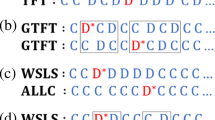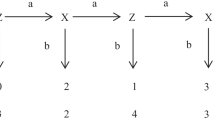Abstract
This article studies the evolution of altruism. We consider a model in which a population of agents are assortatively matched to play some asymmetric two-player game, and evolution operates at the level of behavior rules. We find that the relationship between the evolutionarily stable level of altruism and the index of assortativity of matching is determined by two novel features: (1) whether the total payoff function of the game exhibits complementarity or substitutability; (2) whether the two players’ strategies affect each other’s fitness in the same direction or the opposite. These two features combined generalize the stability conditions related to Hamilton’s rule to a class of asymmetric games.
Similar content being viewed by others
Notes
Such a mechanism is called an indirect evolutionary approach or preference evolution in the literature. See Güth and Yaari (1992), Güth (1995), Bester and Güth (1998), McNamara et al. (1999), Sethi and Somanathan (2001), Ok and Vega-Redondo (2001), Veelen (2006), Dekel et al. (2007), Heifetz et al. (2007a, b), Kuran and Sandholm (2008), Akçay et al. (2009), Alger (2010), and Alger and Weibull (2010, 2012, 2013).
Initiated by Maynard and Parker (1976), many theoretical works have contributed to the understanding of the evolution of strategies in asymmetric games; for example, Taylor (1979), Selten (1980), Hammerstain (1981), Eshel and Akin (1983), Gaunersdorfer et al. (1991), Samuelson and Zhang (1992), Berger (2001), McAvoy and Hauert (2015), and Veller and Hayward (2016), among many others.
Although we allow \(\sigma (\epsilon ) \in [-1,1]\), \(\sigma _{0}\) cannot be negative, otherwise the balancing condition (2) is violated. In other words, when we consider a monomorphic population (\(\epsilon \rightarrow 0\)), negative assortativity is not possible (in this article, we focus on studying the stability of a monomorphic population). For interested readers, negative assortativity has been shown to be a key factor in the evolution of spite. See West and Gardner (2010) and Forber and Smead (2016). Forber and Smead (2016) also note that negative assortativity is not possible in a monomorphic population, so they assume that there is no fitness received from interactions owing to negative assortment (some individuals are unmatched) for their analysis. However, such an assumption may result in instability of any monomorphic population because a large proportion of the incumbents will be unmatched, which severely lowers the incumbents’ expected fitness.
A positive weight represents altruism, a negative weight represents spite, and zero weight represents selfishness.
Ideally, a complete analysis should allow individuals to carry all possible goal functions. However, it would be difficult to conduct an analysis if we allow an arbitrary space of goal functions. We leave this to interested readers.
By implicit function theorem, if a Nash equilibrium is regular, then there exists a neighborhood of \((\alpha , \beta )\) on \(T\times T\) such that both \(x^*(\cdot , \cdot )\) and \(y^*(\cdot , \cdot )\) are continuously differentiable functions of any \((\alpha ', \beta ')\) in this neighborhood.
When multiple Nash equilibria are allowed, differentiability is lost. Moreover, it would be difficult to define expected fitness of the incumbents and the mutants properly because different Nash equilibria give rise to different fitness for each individual.
References
Abbot P, Abe J, Alcock J et al (2011) Inclusive fitness theory and eusociality. Nature 471:E1–E4
Akçay E, Van Cleve J, Feldman M, Roughgarden J (2009) A theory for the evolution of other-regard integrating proximate and ultimate perspectives. Proc Natl Acad Sci USA 106:19061–19066
Alger I (2010) Public goods games, altruism, and evolution. J Public Econ Theory 12:789–813
Alger I, Weibull JW (2010) Kinship, incentives, and evolution. Am Econ Rev 100:1725–1758
Alger I, Weibull JW (2012) A generalization of Hamilton’s rule—Love the sibling how much? J Theor Biol 299:42–54
Alger I, Weibull JW (2013) Homo moralis—Preference evolution under incomplete information and assortative matching. Econometrica 81:2269–2302
Becker G (1981) A treatise on the family. Harvard University Press, Cambridge Enlarged Edition (1993)
Berger U (2001) Best response dynamics for role games. Int J Game Theory 30:527–538
Bergstrom TC (1995) On the evolution of altruistic ethical rules for siblings. Am Econ Rev 85:58–81
Bergstrom TC (2003) The algebra of assortative encounters and the evolution of cooperation. Int Game Theory Rev 5:211–228
Bergstrom TC (2013) Measures of assortativity. Biol Theory 8:133–141
Bester H, Güth W (1998) Is altruism evolutionarily stable? J Econ Behav Org 34:193–209
Binmore K, Shaked A (2010) Experimental economics: where next? J Econ Behav Org 73:87–100
Clavien C, Chapuisat M (2016) The evolution of utility functions and psychological altruism. Stud Hist Philos Biol Biomed Sci 56:24–31
Day T, Taylor PD (1998) Unifying genetic and game theoretic models of kin selection for continuous traits. J Theor Biol 194:391–407
Dekel E, Ely JC, Yilankaya O (2007) Evolution of preferences. Rev Econ Stud 74:685–704
Eshel I, Akin E (1983) Coevolutionary instability of mixed Nash solutions. J Math Biol 18:123–133
Fehr E, Schmidt KM (1999) A theory of fairness, competition, and cooperation. Q J Econ 114(3):817–868
Fehr E, Gintis H (2007) Human motivation and social cooperation: experimental and analytical foundations. Annu Rev Sociol 33:43–64
Forber P, Smead R (2016) The evolution of fairness through spite. Proc R Soc B 281:2439
Gaunersdorfer A, Hofbauer J, Sigmund K (1991) On the dynamics of asymmetric games. Theor Popul Biol 39:345–357
Gintis H, Bowles S, Boyd R, Fehr E (2003) Explaining altruistic behavior in humans. Evol Hum Behav 24:153–172
Grafen A (1979) The hawk-dove game played between relatives. Anim Behav 27:905–907
Güth W (1995) An evolutionary approach to explaining cooperative behavior by reciprocal incentives. Int J Game Theory 24:323–344
Güth W, Yaari M (1992) An evolutionary approach to explain reciprocal behavior in a simple strategic game. In: Witt U (ed) Explaining process and change—Approaches to evolutionary economics. University of Michigan Press, Ann Arbor
Hamilton WD (1964a) The genetical evolution of social behaviour. I. J Theor Biol 7:1–16
Hamilton WD (1964b) The genetical evolution of social behaviour. II. J Theor Biol 7:17–52
Hammerstain P (1981) The role of asymmetries in animal conflicts. Anim Behav 29:193–205
Heifetz A, Shannon C, Spiegel Y (2007a) The dynamic evolution of preferences. Econ Theory 32:251–286
Heifetz A, Shannon C, Spiegel Y (2007b) What to maximize if you must. J Econ Theory 133:31–57
Kuran T, Sandholm WH (2008) Cultural integration and its discontents. Rev Econ Stud 75:201–228
Levine DK (1998) Modeling altruism and spitefulness in experiments. Rev Econ Dyn 1:593–622
Maynard Smith J (1974) The theory of games and the evolution of animal conflicts. J Theor Biol 47:209–221
Maynard Smith J, Parker J (1976) The logic of asymmetric contests. Anim Behav 24:159–175
Maynard Smith J, Price GR (1973) The logic of animal conflicts. Nature 246:15–18
McAvoy A, Hauert C (2015) Asymmetric evolutionary games. PLoS Comput Biol 11(8):e1004349. doi:10.1371/journal.pcbi.1004349
McNamara J, Gasson C, Houston A (1999) Incorporating rules for responding in evolutionary games. Nature 401:368–371
Nowak MA, Tarnita CE, Wilson EO (2010) The evolution of eusociality. Nature 466:1057–1062
Ok EA, Vega-Redondo F (2001) On the evolution of individualistic preferences: an incomplete information scenario. J Econ Theory 97:231–254
Samuelson L, Zhang J (1992) Evolutionary stability in asymmetric games. J Econ Theory 57:363–391
Selten R (1980) A note on evolutionary stable strategics in asymmetric animal conflicts. J Theor Biol 84:93–101
Sethi R, Somanathan E (2001) Preference evolution and reciprocity. J Econ Theory 97:273–297
Taylor PD (1979) Evolutionary stable strategies with two types of player. J Appl Probab 16:76–83
Van Veelen M (2006) Why kin and group selection models may not be enough to explain human other-regarding behaviour. J Theor Biol 242:790–797
Veller C, Hayward LK (2016) Finite-population evolution with rare mutations in asymmetric games. J Econ Theory 162:93–113
West SA, Gardner A (2010) Altruism, spite and greenbeards. Science 327:1341–1344
Wright SG (1921) Systems of mating. Genetics 6:111–178
Wright SG (1922) Coefficients of inbreeding and relationship. Am Nat 56:330–338
Author information
Authors and Affiliations
Corresponding author
Appendix
Appendix
Proof of Lemma 1
By the first-order necessary conditions (14) and (15) for interior Nash equilibrium of \(\Gamma _{mn}\), we can write
Recall that the necessary condition for \(\alpha\) to be evolutionarily stable in a monomorphic population is that the evolutionary drift function \(D(\alpha , \beta )\) (as a function of \(\beta\)) takes value of zero at the point where \(\beta =\alpha\). Hence, we substitute all \(\beta\) in (24) to (27) with \(\alpha\) and plug them into the evolutionarily stationary condition \(D(\alpha , \alpha )=0\), we have:
Q.E.D. \(\square\)
Proof of Theorem 1
Let us first differentiate the first-order necessary conditions (14) and (15) for interior Nash equilibrium of \(\Gamma _{mn}\) with respect to \(\alpha\):
Equations (29) and (30) give us
Next, let us differentiate (14) and (15) with respect to \(\beta\):
Equations (33) and (34) give us
Recall that the necessary condition for \(\alpha\) to be evolutionarily stable in a monomorphic population is that the evolutionary drift function \(D(\alpha , \beta )\) (as a function of \(\beta\)) takes the value of zero at the point where \(\beta =\alpha\). Hence, we replace \(\beta\) in (31), (32), (35), and (36) with \(\alpha\) and plug them into the evolutionarily stationary condition given by (28), we have
The second-order necessary conditions for an interior Nash equilibrium of \(\Gamma _{mn}\) tell us that \(\pi _{n11}+\alpha \pi _{m22}<0\), and \(\pi _{m11}+\alpha \pi _{n22}<0\), and we know \(T_{12}=\pi _{m12}+\pi _{n12}\). Hence, \(\alpha>\sigma _0\) requires that \(\pi _{n2}\pi _{m2}T_{12}>0\), \(\alpha <\sigma _0\) requires that \(\pi _{n2}\pi _{m2}T_{12}<0\), and \(\alpha =\sigma _0\) requires that \(\pi _{n2}\pi _{m2}T_{12}=0\). These give us the desired results as stated in the theorem. Q.E.D. \(\square\)
Rights and permissions
About this article
Cite this article
Wu, J. A Note on Altruism in Asymmetric Games: An Indirect Evolutionary Approach. Biol Theory 12, 181–188 (2017). https://doi.org/10.1007/s13752-017-0269-3
Received:
Accepted:
Published:
Issue Date:
DOI: https://doi.org/10.1007/s13752-017-0269-3




